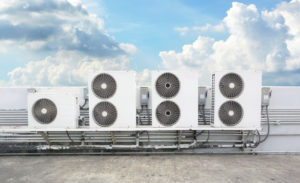 On the minds of all commercial HVAC contractors and manufacturers are a set of recently enacted energy conservation standards for commercial air conditioners, heat pumps, and warm-air furnaces, otherwise known as rooftop units (RTUs). These standards are set to go into effect in 2018 and 2023 and, according to the DOE, will save businesses $167 billion in energy costs over the lifetime of the equipment — more than any other efficiency standard issued to date.
On the minds of all commercial HVAC contractors and manufacturers are a set of recently enacted energy conservation standards for commercial air conditioners, heat pumps, and warm-air furnaces, otherwise known as rooftop units (RTUs). These standards are set to go into effect in 2018 and 2023 and, according to the DOE, will save businesses $167 billion in energy costs over the lifetime of the equipment — more than any other efficiency standard issued to date.
According to former U.S. energy secretary Ernest Moniz, this announcement “marks the largest energy-saving standard in history and demonstrates that America is leading the effort to reduce energy costs and cut carbon emissions. This rule also shows that strong public-private partnerships can reap environmental and economic dividends and drive technology breakthroughs.”
The new rooftop unit (RTU) standards cover new units found on low-rise buildings, like hospitals, schools, and big-box stores and will take effect in two phases, increasing minimum efficiency by about 10 percent as of Jan. 1, 2018, and by 25-30 percent as of Jan. 1, 2023. Standards for new warm-air furnaces, which typically are installed in conjunction with commercial air conditioners, will also become effective in 2023.
Although HVAC manufacturers will be making significant design changes in order to comply with the new regulations, it presents an opportunity for HVAC manufacturers to create new and improved products that will be attractive to customers looking for greater energy savings. These changes require a great deal of work in a little amount of time. The question is, with less than 6 months until implementation, is the industry prepared for this new regulation?
Most companies are prepared and are doing everything they can to comply prior to Jan. 1, 2018. Many in the industry feel that when new regulations are put into place, it challenges manufacturers to incorporate updated platforms with innovative features to reduce energy, provide increased reliability, and improve the installation process. The DOE estimates the new RTU rule will save 1.7 trillion kilowatts hours over 30 years of sales because RTUs cool about half of the commercial space nationwide. The new standards are a win-win for the environment, businesses that use RTUs, manufacturers, distributors, and contractors by saving money on energy bills, lowering emissions, and creating regulatory certainty for manufacturers.
According to Karim Amrane, vice president of regulatory and research at Air-Conditioning, Heating, and Refrigeration Institute (AHRI), “[The rooftop regulation] is something we believe better represents how equipment operates and performs in the field. Manufacturers are going to be ready for 2018 with their available products, and we anticipate a smooth transition.”
Despite its magnitude and looming deadline, the HVAC industry appears ready and willing to do what it takes to meet and, in some cases, exceed this pending national efficiency standard.
#FIELDBOSS #HVACNews #RooftopUnits #RTUStandards